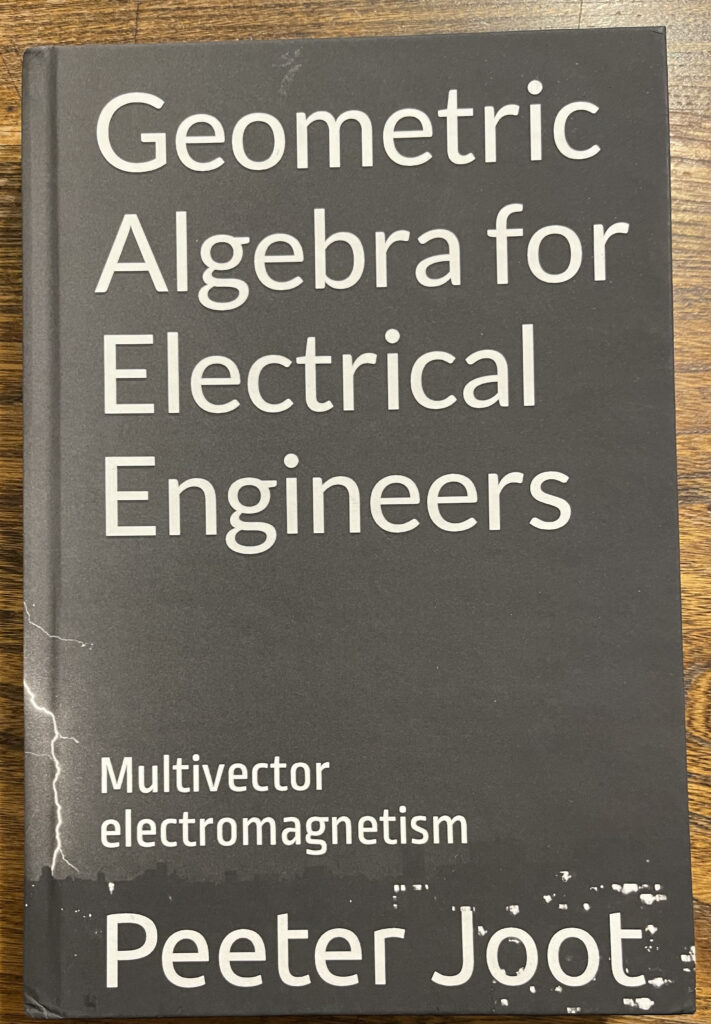[Click here for a PDF version of this post]
I started reviewing a book draft that mentions the adjoint in passing, but I’ve forgotten what I knew about the adjoint (not counting self-adjoint operators, which is different.) I do recall that adjoint matrices were covered in high school linear algebra (now 30+ years ago!), but never really used after that.
It appears that the basic property of the adjoint \( A \) of a matrix \( M \), when it exists, is
\begin{equation}\label{eqn:adjoint:20}
M A = \Abs{M} I,
\end{equation}
so it’s proportional to the inverse, where the numerical factor is the determinant of that matrix. Let’s try to compute this beastie for 1D, 2D, and 3D cases.
Simplest case: \(1 \times 1\) matrix.
For a one by one matrix, say
\begin{equation}\label{eqn:adjoint:40}
M =
\begin{bmatrix}
m_{11}
\end{bmatrix},
\end{equation}
the determinant is just \( \Abs{M} = m_11 \), so our adjoint is the identity matrix
\begin{equation}\label{eqn:adjoint:60}
A =
\begin{bmatrix}
1
\end{bmatrix}.
\end{equation}
Not too interesting. Let’s try the 2D case.
Less trivial case: \(2 \times 2\) matrix.
For the 2D case, let’s define our matrix as a pair of column vectors
\begin{equation}\label{eqn:adjoint:80}
M =
\begin{bmatrix}
\Bm_1 & \Bm_2
\end{bmatrix},
\end{equation}
and let’s write the adjoint out in full in coordinates as
\begin{equation}\label{eqn:adjoint:100}
A =
\begin{bmatrix}
a_{11} & a_{12} \\
a_{21} & a_{22}
\end{bmatrix}.
\end{equation}
We seek solutions to a pair of vector equations
\begin{equation}\label{eqn:adjoint:120}
\begin{aligned}
\Bm_1 a_{11} + \Bm_2 a_{21} &= \Abs{M} \Be_1 \\
\Bm_1 a_{12} + \Bm_2 a_{22} &= \Abs{M} \Be_2.
\end{aligned}
\end{equation}
We can immediately solve either of these, by taking wedge products, yielding
\begin{equation}\label{eqn:adjoint:140}
\begin{aligned}
\lr{ \Bm_1 \wedge \Bm_2 } a_{11} + \lr{ \Bm_2 \wedge \Bm_2 } a_{21} &= \Abs{M} \lr{ \Be_1 \wedge \Bm_2 } \\
\lr{ \Bm_1 \wedge \Bm_1 } a_{11} + \lr{ \Bm_1 \wedge \Bm_2 } a_{21} &= \Abs{M} \lr{ \Bm_1 \wedge \Be_1 } \\
\lr{ \Bm_1 \wedge \Bm_2 } a_{12} + \lr{ \Bm_2 \wedge \Bm_2 } a_{22} &= \Abs{M} \lr{ \Be_2 \wedge \Bm_2 } \\
\lr{ \Bm_1 \wedge \Bm_1 } a_{12} + \lr{ \Bm_1 \wedge \Bm_2 } a_{22} &= \Abs{M} \lr{ \Bm_1 \wedge \Be_2}.
\end{aligned}
\end{equation}
Any wedge with a repeated vector is zero.
Provided the determinant is non-zero, we can divide both sides by \( \Bm_1 \wedge \Bm_2 = \Abs{M} \Be_{12} \) to find a single determinant for each element in the adjoint
\begin{equation}\label{eqn:adjoint:160}
\begin{aligned}
a_{11} &= \begin{vmatrix} \Be_1 & \Bm_2 \end{vmatrix} \\
a_{21} &= \begin{vmatrix} \Bm_1 & \Be_1 \end{vmatrix} \\
a_{12} &= \begin{vmatrix} \Be_2 & \Bm_2 \end{vmatrix} \\
a_{22} &= \begin{vmatrix} \Bm_1 & \Be_2 \end{vmatrix}
\end{aligned}
\end{equation}
or
\begin{equation}\label{eqn:adjoint:400}
A =
\begin{bmatrix}
\begin{vmatrix} \Be_1 & \Bm_2 \end{vmatrix} & \begin{vmatrix} \Be_2 & \Bm_2 \end{vmatrix} \\
& \\
\begin{vmatrix} \Bm_1 & \Be_1 \end{vmatrix} & \begin{vmatrix} \Bm_1 & \Be_2 \end{vmatrix}
\end{bmatrix},
\end{equation}
or
\begin{equation}\label{eqn:adjoint:440}
A_{ij} =
\epsilon_{ir}
\begin{vmatrix}
\Be_j & \Bm_r
\end{vmatrix},
\end{equation}
where \( \epsilon_{ir} \) is the completely antisymmetric tensor, and the Einstein summation convention is in effect (summation implied over any repeated indexes.)
Check:
We should verify that expanding these determinants explicitly reproduces the usual representation of the 2D adjoint:
\begin{equation}\label{eqn:adjoint:420}
\begin{aligned}
\begin{vmatrix} \Be_1 & \Bm_2 \end{vmatrix} &= \begin{vmatrix} 1 & m_{12} \\ 0 & m_{22} \end{vmatrix} = m_{22} \\
\begin{vmatrix} \Bm_1 & \Be_1 \end{vmatrix} &= \begin{vmatrix} m_{11} & 1 \\ m_{21} & 0 \end{vmatrix} = -m_{21} \\
\begin{vmatrix} \Be_2 & \Bm_2 \end{vmatrix} &= \begin{vmatrix} 0 & m_{12} \\ 1 & m_{22} \end{vmatrix} = -m_{12} \\
\begin{vmatrix} \Bm_1 & \Be_2 \end{vmatrix} &= \begin{vmatrix} m_{11} & 0 \\ m_{21} & 1 \end{vmatrix} = m_{11},
\end{aligned}
\end{equation}
or
\begin{equation}\label{eqn:adjoint:180}
A =
\begin{bmatrix}
m_{22} & -m_{12} \\
-m_{21} & m_{11}
\end{bmatrix}.
\end{equation}
Multiplying everything out should give us determinant weighted identity
\begin{equation}\label{eqn:adjoint:200}
\begin{aligned}
M A
&=
\begin{bmatrix}
m_{11} & m_{12} \\
m_{21} & m_{22}
\end{bmatrix}
\begin{bmatrix}
m_{22} & -m_{12} \\
-m_{21} & m_{11}
\end{bmatrix} \\
&=
\lr{ m_{11} m_{22} – m_{12} m_{21} }
\begin{bmatrix}
1 & 0 \\
0 & 1
\end{bmatrix} \\
&= \Abs{M} I,
\end{aligned}
\end{equation}
as expected.
3D case: \(3 \times 3\) matrix.
For the 3D case, let’s also define our matrix as column vectors
\begin{equation}\label{eqn:adjoint:220}
M =
\begin{bmatrix}
\Bm_1 & \Bm_2 & \Bm_3
\end{bmatrix},
\end{equation}
and let’s write the adjoint out in full in coordinates as
\begin{equation}\label{eqn:adjoint:240}
A =
\begin{bmatrix}
a_{11} & a_{12} & a_{13} \\
a_{21} & a_{22} & a_{23} \\
a_{31} & a_{32} & a_{33}
\end{bmatrix}.
\end{equation}
This time, we seek solutions to three vector equations
\begin{equation}\label{eqn:adjoint:260}
\begin{aligned}
\Bm_1 a_{11} + \Bm_2 a_{21} + \Bm_3 a_{31} &= \Abs{M} \Be_1 \\
\Bm_1 a_{12} + \Bm_2 a_{22} + \Bm_3 a_{32} &= \Abs{M} \Be_2 \\
\Bm_1 a_{13} + \Bm_2 a_{23} + \Bm_3 a_{33} &= \Abs{M} \Be_3,
\end{aligned}
\end{equation}
and can immediately solve, once again, by taking wedge products, yielding
\begin{equation}\label{eqn:adjoint:280}
\begin{aligned}
\lr{ \Bm_1 \wedge \Bm_2 \wedge \Bm_3 }a_{11} + \lr{ \Bm_2 \wedge \Bm_2 \wedge \Bm_3 }a_{21} + \lr{ \Bm_3 \wedge \Bm_2 \wedge \Bm_3 }a_{31} &= \Abs{M} \Be_1 \wedge \Bm_2 \wedge \Bm_3 \\
\lr{ \Bm_1 \wedge \Bm_1 \wedge \Bm_3 }a_{11} + \lr{ \Bm_1 \wedge \Bm_2 \wedge \Bm_3 }a_{21} + \lr{ \Bm_1 \wedge \Bm_3 \wedge \Bm_3 }a_{31} &= \Abs{M} \Bm_1 \wedge \Be_1 \wedge \Bm_3 \\
\lr{ \Bm_1 \wedge \Bm_2 \wedge \Bm_1 }a_{11} + \lr{ \Bm_1 \wedge \Bm_2 \wedge \Bm_2 }a_{21} + \lr{ \Bm_1 \wedge \Bm_2 \wedge \Bm_3 }a_{31} &= \Abs{M} \Bm_1 \wedge \Bm_2 \wedge \Be_1 \\
\lr{ \Bm_1 \wedge \Bm_2 \wedge \Bm_3 }a_{12} + \lr{ \Bm_2 \wedge \Bm_2 \wedge \Bm_3 }a_{22} + \lr{ \Bm_3 \wedge \Bm_2 \wedge \Bm_3 }a_{32} &= \Abs{M} \Be_2 \wedge \Bm_2 \wedge \Bm_3 \\
\lr{ \Bm_1 \wedge \Bm_1 \wedge \Bm_3 }a_{12} + \lr{ \Bm_1 \wedge \Bm_2 \wedge \Bm_3 }a_{22} + \lr{ \Bm_1 \wedge \Bm_3 \wedge \Bm_3 }a_{32} &= \Abs{M} \Bm_1 \wedge \Be_2 \wedge \Bm_3 \\
\lr{ \Bm_1 \wedge \Bm_2 \wedge \Bm_1 }a_{12} + \lr{ \Bm_1 \wedge \Bm_2 \wedge \Bm_2 }a_{22} + \lr{ \Bm_1 \wedge \Bm_2 \wedge \Bm_3 }a_{32} &= \Abs{M} \Bm_1 \wedge \Bm_2 \wedge \Be_2 \\
\lr{ \Bm_1 \wedge \Bm_2 \wedge \Bm_3 }a_{13} + \lr{ \Bm_2 \wedge \Bm_2 \wedge \Bm_3 }a_{23} + \lr{ \Bm_3 \wedge \Bm_2 \wedge \Bm_3 }a_{33} &= \Abs{M} \Be_3 \wedge \Bm_2 \wedge \Bm_3 \\
\lr{ \Bm_1 \wedge \Bm_1 \wedge \Bm_3 }a_{13} + \lr{ \Bm_1 \wedge \Bm_2 \wedge \Bm_3 }a_{23} + \lr{ \Bm_1 \wedge \Bm_3 \wedge \Bm_3 }a_{33} &= \Abs{M} \Bm_1 \wedge \Be_3 \wedge \Bm_3 \\
\lr{ \Bm_1 \wedge \Bm_2 \wedge \Bm_1 }a_{13} + \lr{ \Bm_1 \wedge \Bm_2 \wedge \Bm_2 }a_{23} + \lr{ \Bm_1 \wedge \Bm_2 \wedge \Bm_3 }a_{33} &= \Abs{M} \Bm_1 \wedge \Bm_2 \wedge \Be_3,
\end{aligned}
\end{equation}
Any wedge with a repeated vector is zero.
Like before, provided the determinant is non-zero, we can divide both sides by \( \Bm_1 \wedge \Bm_2 \wedge \Bm_3 = \Abs{M} \Be_{123} \) to find a single determinant for each element in the adjoint
\begin{equation}\label{eqn:adjoint:360}
\begin{aligned}
A &=
\begin{bmatrix}
\begin{vmatrix} \Be_1 & \Bm_2 & \Bm_3 \end{vmatrix} & \begin{vmatrix} \Be_2 & \Bm_2 & \Bm_3 \end{vmatrix} & \begin{vmatrix} \Be_3 & \Bm_2 & \Bm_3 \end{vmatrix} \\
& & \\
\begin{vmatrix} \Bm_1 & \Be_1 & \Bm_3 \end{vmatrix} & \begin{vmatrix} \Bm_1 & \Be_2 & \Bm_3 \end{vmatrix} & \begin{vmatrix} \Bm_1 & \Be_3 & \Bm_3 \end{vmatrix} \\
& & \\
\begin{vmatrix} \Bm_1 & \Bm_2 & \Be_1 \end{vmatrix} & \begin{vmatrix} \Bm_1 & \Bm_2 & \Be_2 \end{vmatrix} & \begin{vmatrix} \Bm_1 & \Bm_2 & \Be_3 \end{vmatrix}
\end{bmatrix} \\
&=
\begin{bmatrix}
\begin{vmatrix} \Be_1 & \Bm_2 & \Bm_3 \end{vmatrix} & \begin{vmatrix} \Be_2 & \Bm_2 & \Bm_3 \end{vmatrix} & \begin{vmatrix} \Be_3 & \Bm_2 & \Bm_3 \end{vmatrix} \\
& & \\
\begin{vmatrix} \Be_1 & \Bm_3 & \Bm_1 \end{vmatrix} & \begin{vmatrix} \Be_2 & \Bm_3 & \Bm_1 \end{vmatrix} & \begin{vmatrix} \Be_3 & \Bm_3 & \Bm_1 \end{vmatrix} \\
& & \\
\begin{vmatrix} \Be_1 & \Bm_1 & \Bm_2 \end{vmatrix} & \begin{vmatrix} \Be_2 & \Bm_1 & \Bm_2 \end{vmatrix} & \begin{vmatrix} \Be_3 & \Bm_1 & \Bm_2 \end{vmatrix}
\end{bmatrix},
\end{aligned}
\end{equation}
or
\begin{equation}\label{eqn:adjoint:380}
A_{ij} = \frac{\epsilon_{irs}}{2!} \begin{vmatrix} \Be_j & \Bm_r & \Bm_s \end{vmatrix}.
\end{equation}
Observe that the inclusion of the \( \Be_j \) column vector in this determinant, means that we really need only compute a \( 2 \times 2 \) determinant for each adjoint matrix element. That is
\begin{equation}\label{eqn:adjoint:480}
A_{ij} = \frac{(-1)^j \epsilon_{irs}\epsilon_{jab}}{(2!)^2}
\begin{vmatrix}
m_{ar} & m_{as} \\
m_{br} & m_{bs}
\end{vmatrix}
.
\end{equation}
This looks a lot like the usual minor/cofactor recipe, but written out explicitly for each element, using the antisymmetric tensor to encode the index alternation. It’s worth noting that there may be an error or subtle difference from the usual in my formulation, since wikipedia defines the adjoint as the transpose of the cofactor matrix, see: [1].
General case: \(n \times n\) matrix.
It appears that if we wanted an induction hypotheses for the general \( n > 1 \) case, the \( ij \) element of the adjoint matrix is likely
\begin{equation}\label{eqn:adjoint:460}
\begin{aligned}
A_{ij} &= \frac{\epsilon_{i s_1 s_2 \cdots s_{n-1}}}{(n-1)!} \begin{vmatrix} \Be_j & \Bm_{s_1} & \Bm_{s_2} & \cdots & \Bm_{s_{n-1}} \end{vmatrix} \\
&= \frac{(-1)^j \epsilon_{i r_1 r_2 \cdots r_{n-1}} \epsilon_{j s_1 s_2 \cdots s_{n-1}} }{\lr{(n-1)!}^2}
\begin{vmatrix}
m_{r_1 s_1} & \cdots & m_{r_1 s_{n-1}} \\
\vdots & & \vdots \\
m_{r_{n-1} s_{1}} & \cdots & m_{r_{n-1} s_{n-1}}
\end{vmatrix}.
\end{aligned}
\end{equation}
I’m not going to try to prove this, inductively or otherwise.
References
[1] Wikipedia contributors. Minor (linear algebra) — Wikipedia, the free encyclopedia, 2023. URL https://en.wikipedia.org/w/index.php?title=Minor_(linear_algebra)&oldid=1182988311. [Online; accessed 16-January-2024].
Like this:
Like Loading...





